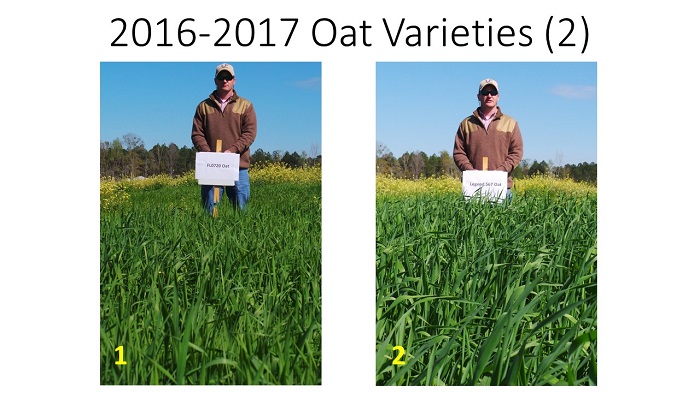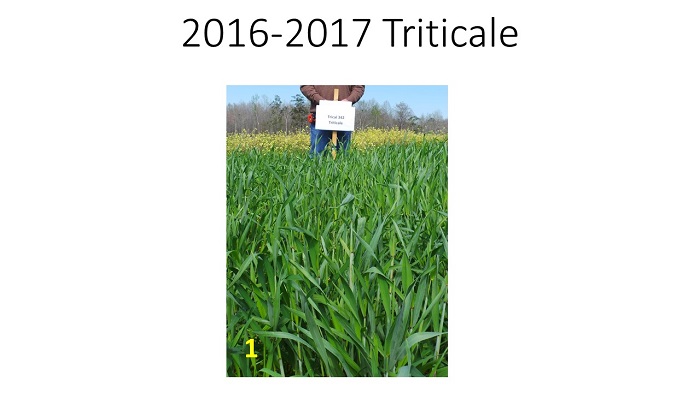Every fall producers select which cool season forage varieties they want to utilize in their operations and by the following spring some are happy with the choices they made and others are not. In an effort to help producers make a more informed decision, UF/IFAS personnel, with funding from the Florida Milk Check-Off, plant a series of forage variety demonstrations across the state. These demonstrations give producers the opportunity to see how varieties perform in multiple locations and under a variety of “real-life” management systems. One of these demonstrations was planted on a farm in Washington County.
The following observations from the demonstration are just that, observations, not recommendations. This planting was not intended for formal research and no conclusions should be drawn from the following descriptions/observations.
Washington County Milk Check-Off Cool Season Forage Demonstration
- Planted December 14, 2016
- All seed was broadcast on a prepared seedbed and then cut-in with a disc harrow
- The demonstration site, in western Washington County, is entirely Dothan Sandy Loam soil
- Fertilized one time, January 19, 2017, with 60lbs/ac N, 80lbs/ac P2O5, 80lbs/ac K2O
- The demo has received no irrigation (other than rainfall) and has not been grazed.
All of the pictures were taken on March 16, 2017, 91 days after planting. To help provide some perspective, the placard used to hold the signs with the variety names has two stripes. The lower stripe is 12 inches above the ground, the upper stripe is 24 inches above the ground and the bottom of the white sign in 30 inches above the ground. The approximate observed heights are provided for each variety. These values are not scientific measurements, only informal observations. The values are only included because the pictures are small and may be difficult to see, they are not necessarily an accurate representation of the total amount of forage present or the quality thereof.
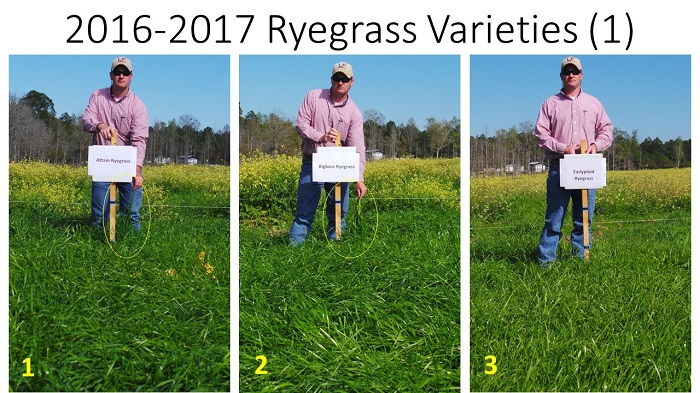
Variety 1 = Attain Ryegrass
Variety 2 = Bigboss Ryegrass
Variety 3 = Earlyploid Ryegrass
Photo Credit: Ethan Carter & Mark Mauldin

Variety 1 = TAMTBO Ryegrass
Variety 2 = Prine Ryegrass
Variety 3 = Common Gulf Annual Ryegrass
Photo Credit: Ethan Carter & Mark Mauldin
All of the ryegrass varieties had a seeding rate of 25lbs/ac. Ryegrass does not grow in a very erect manner, the larger it gets the more it tends to bend back toward the ground. Hence the reason some varieties are being held up in the photos. It should be noted that because Gulf Annual Ryegrass is Common and is not a certified vairiety, Gulf performance can vary tremendously from bag to bag.
2016-2017 Ryegrass Varieties (1)
- Attain Ryegrass, approximate observed height: 28 inches
- Bigboss Ryegrass, approximate observed height: 26 inches
- Earlyploid Ryegrass, approximate observed height: 14 inches
2016-2017 Ryegrass Varieties (2)
- TAMTBO Ryegrass, approximate observed height: 32 inches
- Prine Ryegrass, approximate observed height: 12 inches
- Common Gulf Annual Ryegrass, approximate observed height: 16 inches

Variety 1 = Buck Forage Oat, LA 99017
Variety 2 = Coker 227 Oat
Variety 3 = Ram Oat, LA99016
Photo Credit: Ethan Carter & Mark Mauldin
All of the oat varieties had a seeding rate of 120lbs/ac.
2016-2017 Oat Varieties (1)
- Buck Forage Oat, LA 99017, approximate observed height: 22 inches
- Coker 227 Oat, approximate observed height: 13 inches
- Ram Oat, LA 99016, approximate observed height: 14 inches
2016-2017 Oat Varieties (2)
- FL0720 Oat, approximate observed height: 25 inches
- Legend 567 Oat, approximate observed height: 36 inches
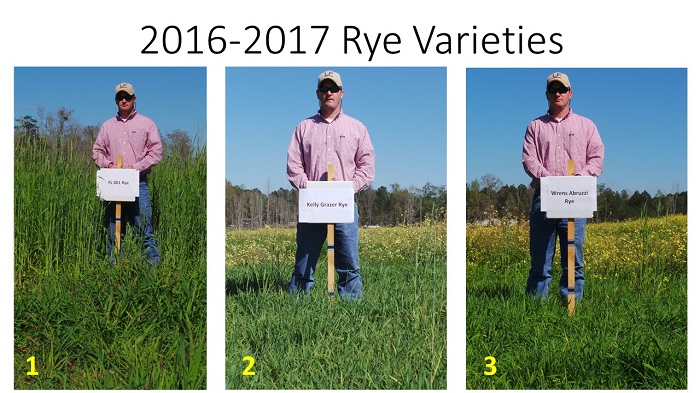
Variety 1 = FL 401 Rye
Variety2 = Kelly Grazer Rye
Variety 3 = Wrens Abruzzi Rye
Photo Credit Ethan Carter & Mark Mauldin
All of the rye varieties had a seeding rate of 120lbs/ac. Note: The FL 401 Rye is the variety behind the placard, in all other photos the named variety is in front of the placard. The FL 401 Rye has completed its vegetative growth and produced seed. The other rye varieties are still in the vegetative growth stage.
2016-2017 Rye Varieties
- FL 401 Rye, approximate observed height: 46 inches
- Kelly Grazer Rye, approximate observed height: 14 inches
- Wrens Abruzzi Rye, approximate observed height: 11 inches
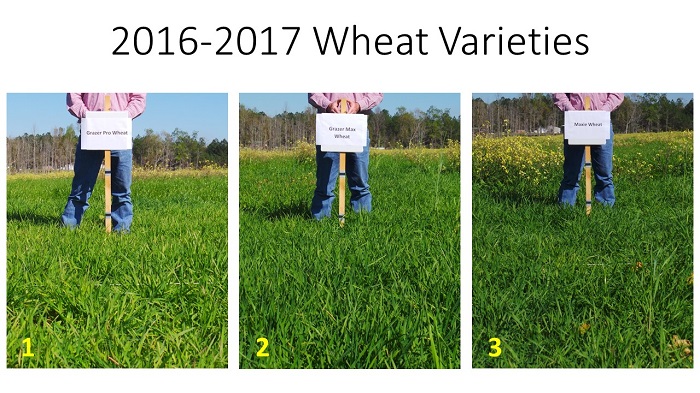
Variety 1 = Grazer Pro Wheat
Variety 2 = Grazer Max Wheat
Variety 3 = Maxie Wheat
Photo Credit: Ethan Carter & Mark Mauldin
All of the wheat varieties had a seeding rate of 120lbs/ac.
2016-2017 Wheat Varieties
- Grazer Pro Wheat, approximate observed height: 11 inches
- Grazer Max Wheat, approximate observed height: 13 inches
- Maxie Wheat, approximate observed height: 12 inches
The triticale variety had a seeding rate of 120lbs/ac. The approximate observed height of Trical 342 Triticale was 26 inches.

Variety 1 = Trical 342 Triticale + Earlyploid Ryegrass
Variety 2 = Wrens Abruzzi Rye + Coker 227 Oat
Variety 3 = Wrens Abruzzi Rye + Earlyploid Rye Grass
Photo Credit: Ethan Carter & Mark Mauldin
The seeding rates for all of the blends was 120lbs/ac. The Trical 342 Triticale + Earlyploid Ryegrass was an 80:20 mixture (96lbs Trical + 24lbs Earlyploid). The other two blends were 50:50 mixtures.
2016-2017 Cool Season Forage Blends
- Trical 342 Triticale + Earlyploid Ryegrass, approximate observed height: 24 inches
- Wrens Abruzzi Rye + Coker 227 Oat, approximate observed height: 12 inches
- Wrens Abruzzi Rye + Earlyploid Ryegrass, approximate observed height: 12 inches
Remember, these are just observations from one location at one moment in time. With different weather, soil, or management this demonstration could have looked very different. For example, this has been a very mild winter. This likely favored forages that prefer mild temperatures, like oats. This demonstration, while not irrigated, has had adequate moisture from planting through the time these observations were made. This abundance of moisture prevented the rye from showing its drought tolerance and favored moisture loving species, like ryegrass.
Perhaps the most important thing to remember when viewing this demonstration is the planting date. Due to extremely dry, followed immediately by excessively wet conditions, this demo was not planted until December 14. That is a full month outside the recommended planting window for cool season forages.The pictures above were taken in mid-March, but the plants were only 3 months old. In a “normal” year annual forages would be at least 4 months old in mid-March. All of that translates to the fact that the earlier maturing varieties looked the best when the pictures were taken. In my opinion, the two most noticeable images were of the FL 401 Rye and the Legend 567 Oat. Both of these varieties showed tremendous growth. That stands to reason considering that they were both bred to provide cool season forage as early as possible.
Year in, year out, more early growth does not necessarily mean more total growth but in a late planting situation like we had this year it likely will. These early varieties complete their life cycle more rapidly than their later counterparts do. While this appears to have been a benefit in this situation, remember the faster a plant reaches its reproductive phase (making seed) the faster it stops producing foliage. No single variety is perfect for every situation. Contact your county’s Agriculture Agent for more information on any of the varieties discussed above and how they could potentially fit into your operation.


